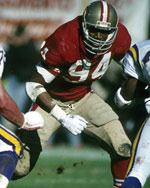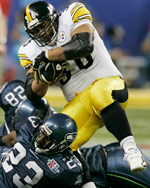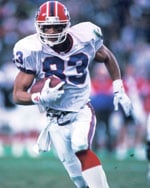Do championships make a Hall of Famer?
“There has long been a correlation between championships and enshrinement.” – Rick Gosselin, Hall of Fame selector |
"Lynn Swann's career statistics would make him a longshot for induction into the Pro Football Hall of Fame. But his performance on the largest stage -- the playoffs and Super Bowls -- earned him his bust in Canton," shared veteran selector Rick Gosselin of the Dallas Morning News. "There has long been a correlation between championships and enshrinement. That's why there are nine Browns from the 1950s in Canton, 10 Packers from the 1960s and nine Steelers from the 1970s. Greatness is an ability to produce when it matters most. The Pro Football Hall of Fame pays homage to that greatness."
Gosselin and the rest of the Pro Football Hall of Fame Selection Committee will have a tough assignment on Saturday, Feb. 4 when they participate in the annual selection meeting in Indianapolis. The Selection Committee can elect no more than five modern-era candidates. The list of 15 modern-era finalists for the Class of 2012 have combined to be a part of 49 conference championship game appearances and played in a total of 22 Super Bowls. And, there are 13 Super Bowl rings that have been awarded to this year's group of finalists. Add in the senior nominees, two stars from the 1950s, and there are three more NFL championship appearances and a pair of league titles.
Two of the modern-era finalists are not players but have a record of great success in the playoffs. Longtime San Francisco 49ers owner Edward DeBartolo, Jr. built an organization that advanced to the NFC conference championship game 10 times and won half of them. After each of the conference championship wins, San Francisco followed with Super Bowl victories. The team, under DeBartolo, became the first NFL franchise to capture five Super Bowl titles.
Bill Parcells is the first and only coach to lead four different teams to the postseason. Three of his clubs, the New York Giants, New England Patriots, and New York Jets – advanced to a conference championship game. Two, the Giants and Patriots – earned a berth in the Super Bowl with New York winning a pair of Super Bowl titles (XXI and XXV).
 |
| Charles Haley is the only player to win five Super Bowls. |
Linebacker Kevin Greene advanced to the conference championship game with each of the four teams for which he played (two with the Los Angeles Rams and Steelers, and one each with the 49ers and Carolina Panthers). His lone victory came in 1995 when Pittsburgh beat the Indianapolis Colts 20-16 to advance to Super Bowl XXX. Greene started at left outside linebacker in the game and contributed with one tackle, four assists and picked up a half of a sack. A teammate that year was center Dermontti Dawson, who like Greene, enjoyed the only championship win of his career. Dawson played in two other AFC title bouts, both of which were narrow losses, for the Steelers. The 1995 Pittsburgh team with Dawson and Greene lost to the Cowboys in Super Bowl XXX.
 |
| Jerome Bettis scored a TD in each of the four conference championship games in which he played. |
Martin started in two AFC championships, a win with the 1996 Patriots and the other with the Jets two years later. His lone Super Bowl appearance came in the Patriots loss to the Packers. However, Martin contributed with his usual versatility by blending a nice mix of rushing and receiving in all three games.
Like Bettis, cornerback/safety Aeneas Williams had to wait until late in his career to enjoy the thrill of playing in a Super Bowl. After playing 10 seasons with the Phoenix/Arizona Cardinals, he relished the chance to play for the NFL crown when he joined the St. Louis Rams in 2001. The team rolled to a 14-2 record in the regular season and kept the show going in the playoffs. Williams had
 |
| Andre Reed’s 27 career catches in the Super Bowl is second only to Jerry Rice and his 323 career yards is third behind Rice and Lynn Swann. |
The three wide receivers among the finalists were also no strangers to conference championships. Tim Brown played in three with the Raiders, Cris Carter a pair with the Vikings, and Andre Reed started in five AFC championship games over a six-season period. He was an integral part of the Buffalo Bills' four straight Super Bowl appearances in the early 1990s.
Brown's best performance in a conference title game came in the lone win he experienced as he had nine catches for 73 yards to help Oakland beat the Tennessee Titans in 2002. Carter and the Vikings played in two NFC championships in a three-year span but never advanced to the Super Bowl. Reed and the Bills won four straight AFC titles but never were able to hoist the Vince Lombardi Trophy. Reed's finest performance in a conference title came in the Bills only loss in 1988 when he had five catches for 55 yards and Buffalo's lone TD. He had strong games in each of the Super Bowls including Super Bowl XXVII when he had eight catches for 152 yards.
Chris Doleman started a pair of conference championship games, one with Minnesota in 1987 and the other in 1997 with the 49ers. Neither squad advanced to the Super Bowl. Guard Will Shields only had the opportunity to play in one championship game during his career with the Chiefs, a 30-13 loss to Buffalo in the 1993 AFC Championship Game. Only two modern-era finalists, Cortez Kennedy and Willie Roaf, played for teams that never reached a conference championship.
The Haggar Gold Jacket Report
Hall of Fame linebacker Bobby Bell took time out of his schedule to honor one of the ten finalists for the U.S. Army – Pro Football Hall of Fame – Award for Excellence. That's just one of the stories about Pro Football Hall of Famers in the news.
Playoff record ball arrives
The football used in the Saints’ record-breaking Wild Card victory is the most recent addition to the Hall of Fame’s collection.

